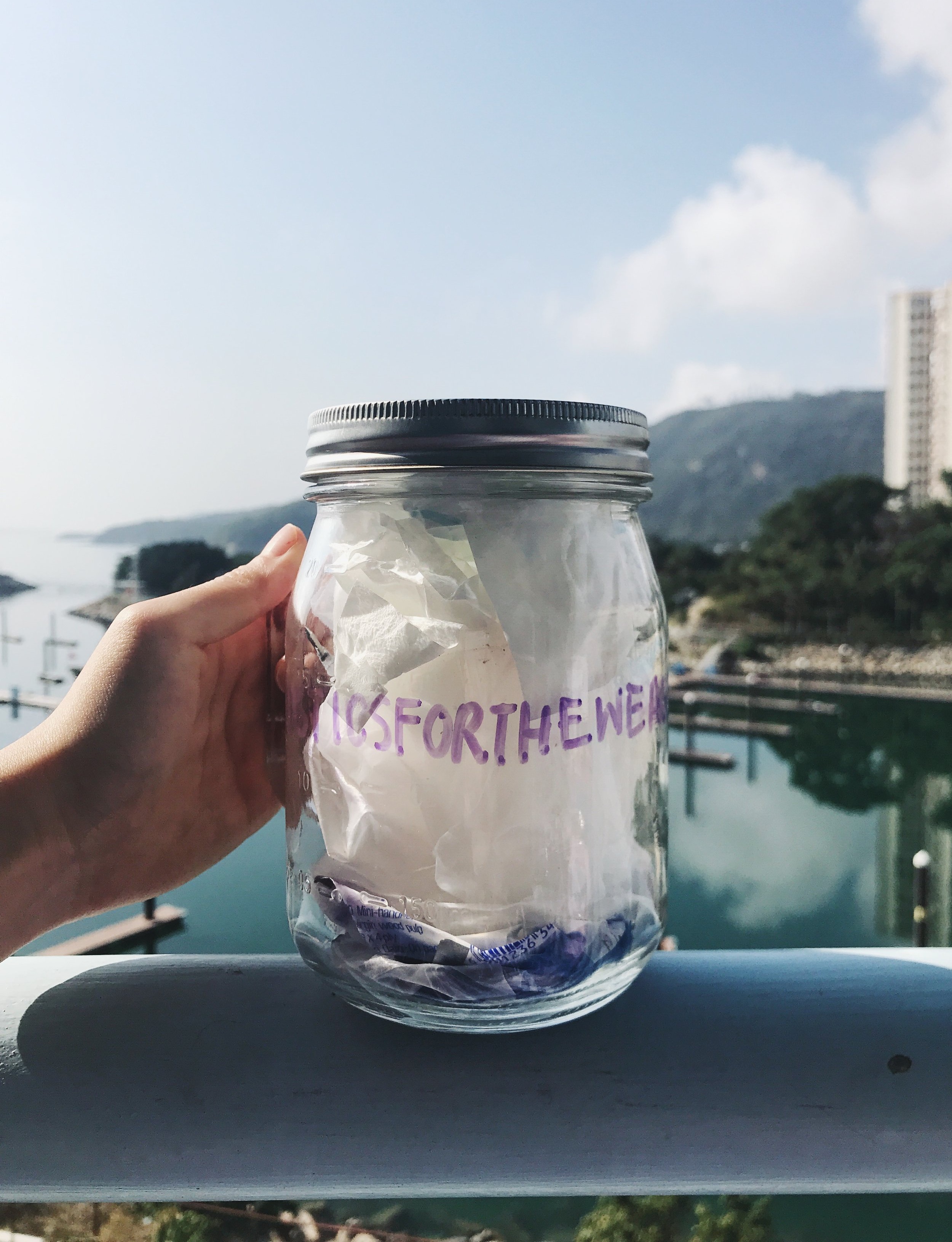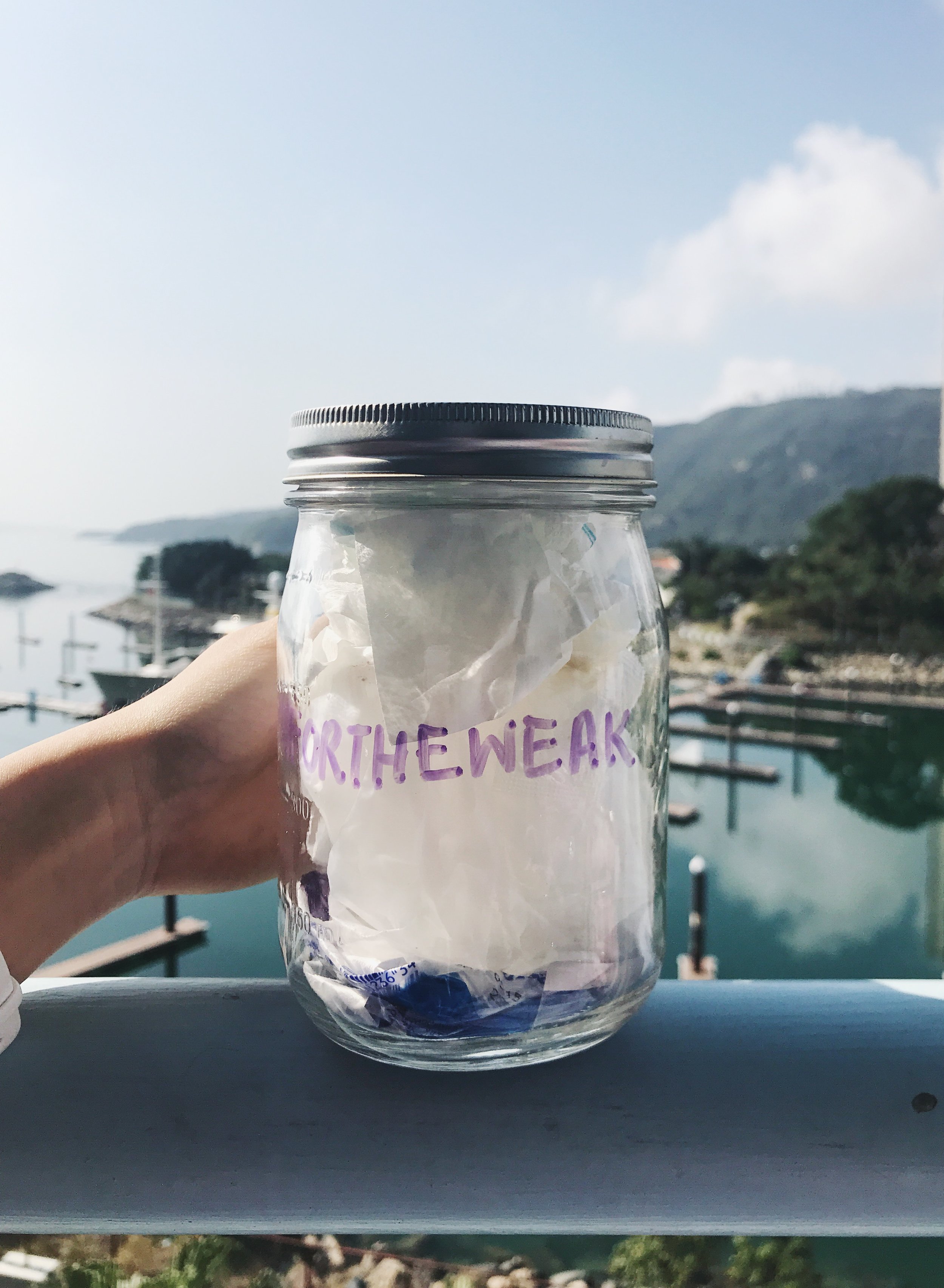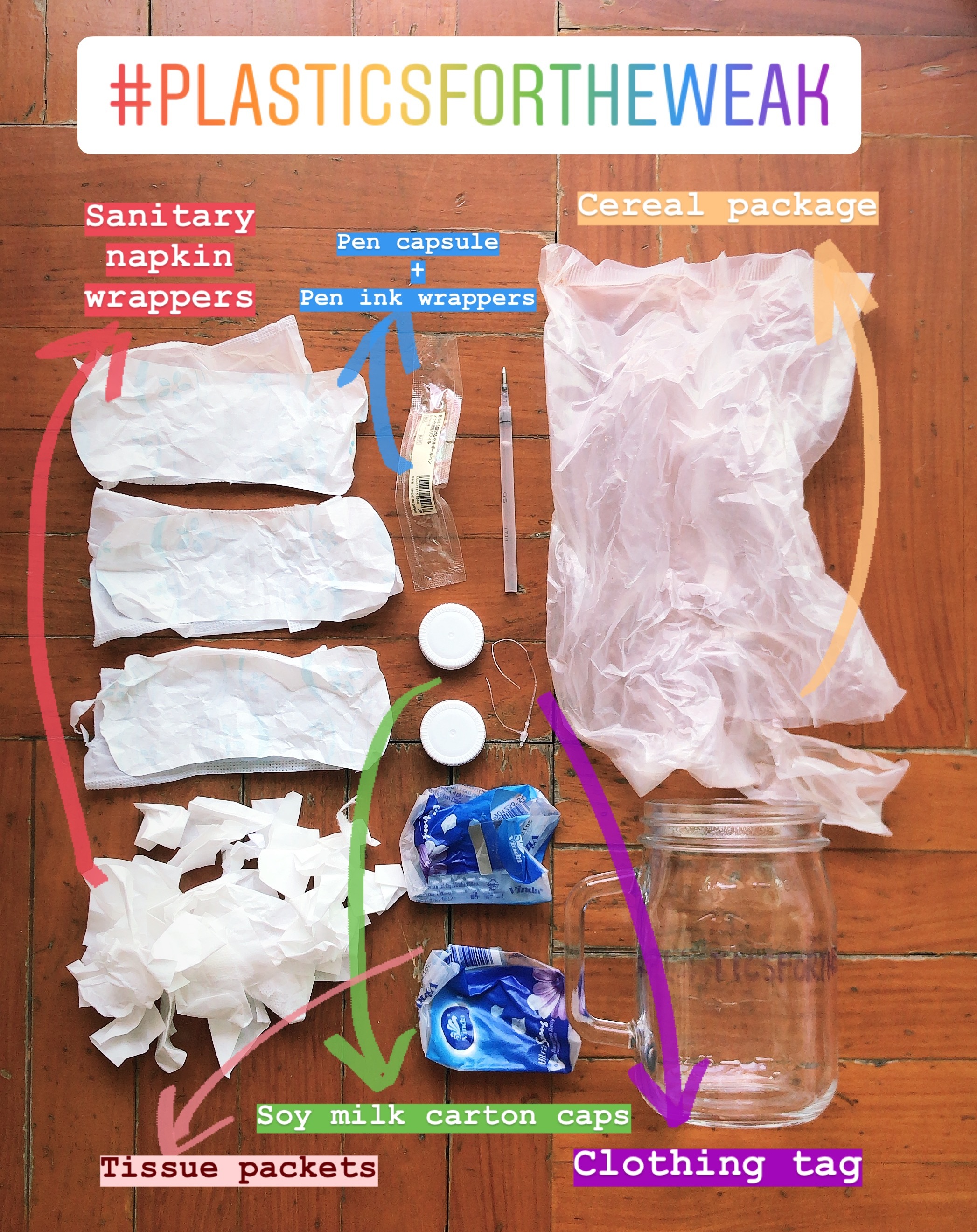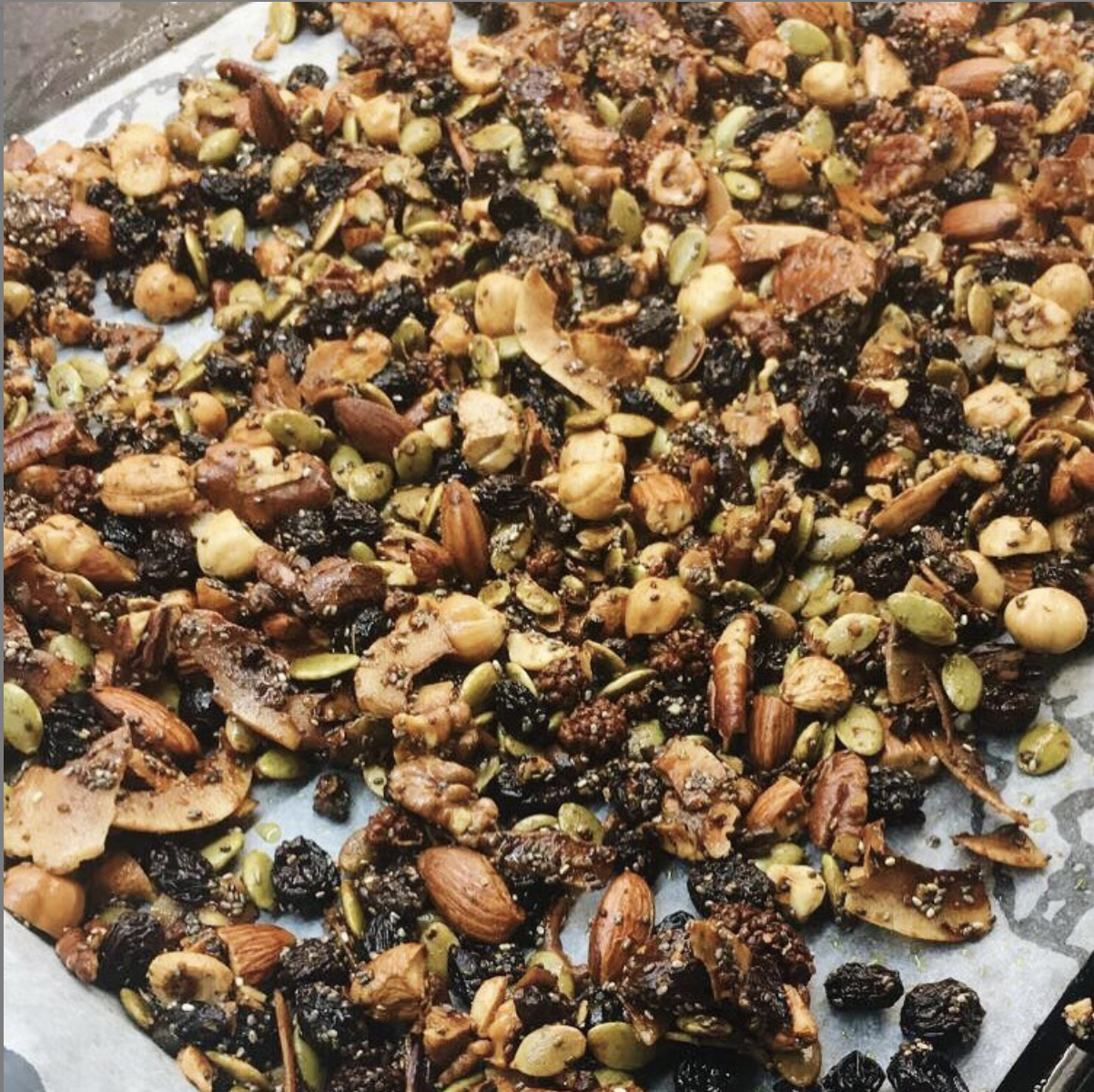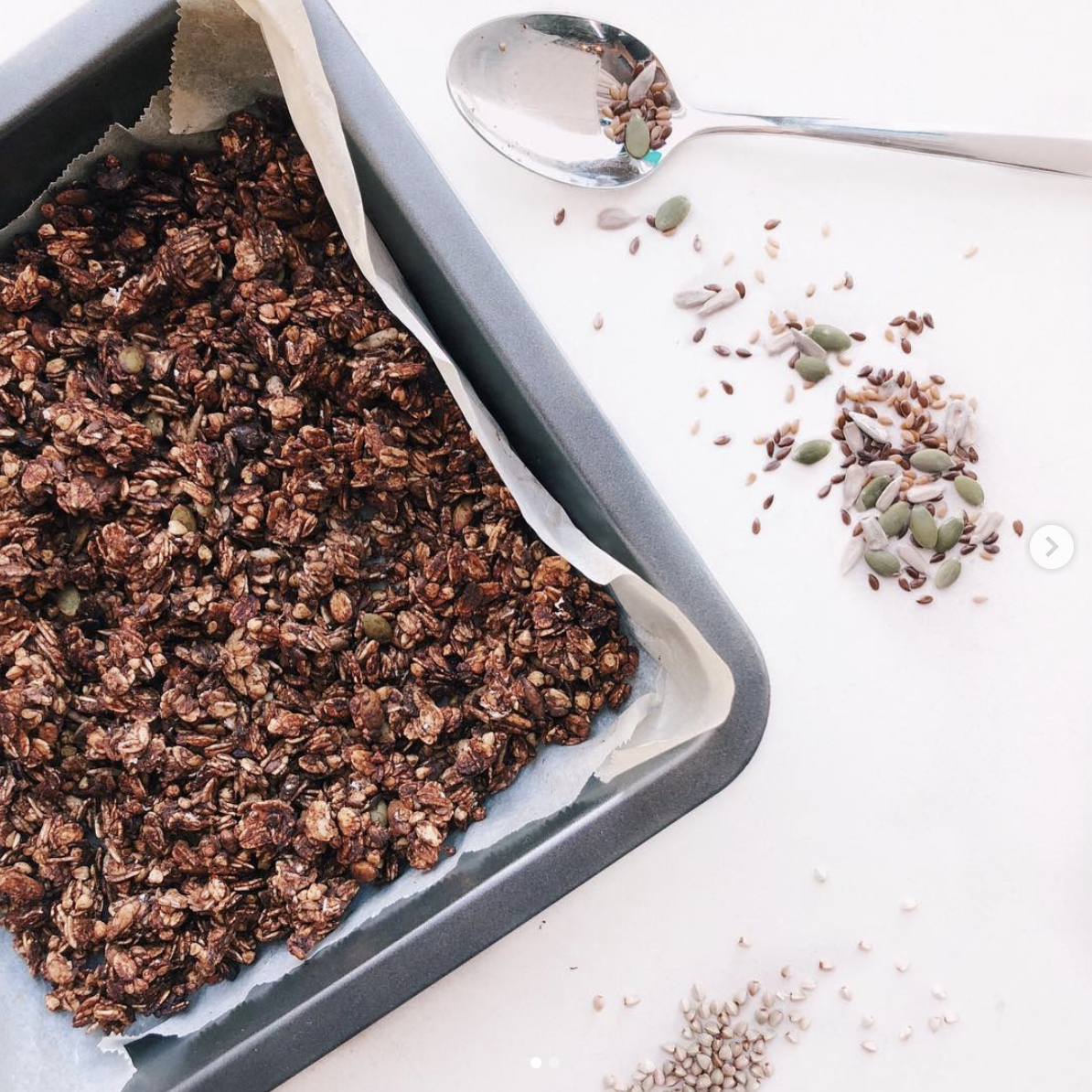As a member of Bye Bye Plastic Bags Hong Kong, I spent the 7th-16th of January participating in a Zero Waste challenge where I collected all the plastic I used in a 16-ounce mason jar. The objective was to monitor the amount of daily plastic consumed and devise creative ways to limit what goes in - all the while having fun and raising awareness through sharing my progress through Instagram.
Although some may view this as a counterintuitive method to promote sustainability and encourage low-waste living (as zero-waste should be a lifestyle as opposed to temporary change), I found it to be a largely enlightening experience - one that will influence (and has influenced) my future behaviour. I grew more aware of the mindless consumption that I - someone who claims to promote a ‘low-waste lifestyle’ - mindlessly generate if not cautious, and I realized how simple it is to fall prey to consumerism if not selective with the items I purchase. The daunting reality is that plastic is ubiquitous, and even if we actively attempt to minimize the amount we consume, there is likely to be lots lurking around your home. So without further ado, below are the main items I added to my jar, followed by my thoughts on how to rectify our habits and diminish our contribution to the problem of plastic waste.
The Plastic I Collected During The #Plasticsfortheweak Challenge
Sanitary Napkins
It just so happened that my period landed on this ten-day challenge, but for the sake of this blog post, I’m grateful for the educational opportunities it provides. I recently switched over to reusable cloth ones from Delightfully Green, however, I’m still in the midst of completing half-finished packets of disposable sanitary pads - hence, the wrappers pictured above. The pile of sanitary napkin packaging stickers on the bottom left of the image demonstrates our dependence on single-use plastics even for the most fundamental purchases, and considering the majority of women continue to rely on these to endure their monthly menstruations, the amount of single-use sanitary napkins that wind up in our landfills is hardly fathomable.
Part of the problem lies in the fact that any discussion of periods is still rendered taboo, but I hope that by broaching the topic and exploring the environmental side of it here and on my original Embarking on a Zero Waste Journey post paves way for more open conversation on how we can alleviate our plastic usage in this plastic-laden department. If you are interested in purchasing a reusable cloth pad from Delightfully Green, I would recommend experimenting with the night ones first. In terms of convenience, the day ones aren’t as ideal since they require a brief rinse immediately after usage - making it difficult to wear in public. Alternatively, you could opt for the DivaCup (which I have not tried but heard works wonders) - which can be used for up to 12 hours in one go.
Pen Capsules (and their accompanying wrappers)
Studies show that taking notes by hand allows you to remember and recall material better than by typing them up. There’s also a rule at my school that all assessments must be completed using a blue or black ballpoint pen. Thus, this black pen from MUJI has become my go-to, and I’ve refilled it approximately twelve times since the start of my IB career. Seeing that it contains a refillable ink capsule, it is arguably more ‘sustainable’ that most pens - due to its long-lasting nature and ability to be reused. I didn’t notice, however, how much plastic waste the practice of removing and refilling this pen had generated until I needed to replace it during the 10-day challenge. The extent to which single-use plastics have permeated our lives is incredible - to think that at some point, this material didn’t exist is unfathomable - but also frustrating is how it seems unavoidable. Sometimes you’ll think you’re doing a great job at lowering your levels of waste, when suddenly, you notice that EVERYTHING AROUND YOU is coated in plastic. It’s disheartening, really, but I suppose that’s part of the challenge. Perhaps I’ll revert to pencils after I graduate and am granted the flexibility to select my own stationery, but what’s frightening is that what’s been bought has already been bought. There’s no throwing them ‘away,’ there is only 'watch out for what you buy next.’
Carton Caps
The most easily solvable item on this list: Carton caps and their accompanying Tetra-Pak containers used to store coconut water or soy milk. Although my entire family indulges in these Tetra-Pak beverages, I am guilty of exacerbating the problem by simply doing the same. It is often that one extra step which hinders us from truly reducing our waste - and for me, the idea of having to travel to a bulk food store or “milk my own almonds” seems like a tedious chore, resulting in a convenient purchase of supermarket soy milk instead. This will change, though, and I am working on it. As I write, my almonds are being soaked in a bowl, waiting to be ‘milked.’ There will be an update on that, but as for now, baby steps.
Tissue Wrappers
I happened to have had a severe running nose during the time of this challenge, which didn’t help with maintaining an empty-as-possible jar. I actually tried to do something about this before - by carrying around a handkerchief that my mom gave me over the summer - but most of the time, the cloth would simply get lost in my bag, attracting all the weird dusty things lurking in my bag, and it would turn out to be far less hygienic than I expected. Especially when it came to blowing my nose, I didn’t see how that would work, so I ended up reverting back to my old ways of using regular tissues. If you have an effective way to combat this issue, I’d love to know, but in the meantime, I’m going to continue experimenting with alternatives until I find something that works.
Clothing Tag
In all honesty, I can’t recall where this tag came from, but I’m assuming it was from an item of clothing which I purchased and that I can prevent it from happening again (or at least at a greater scale). The detriment this small plastic tag poses to our environment is far less significant than what the clothing industry does, so I’m going to pull in a few (not so) fun facts here to hopefully incentivise you, and remind me, to dodge the environmental (and ethical) bullet of fast fashion: “Cotton represents nearly half of the total fiber used to make clothing today. More than 90% of that cotton is now genetically modified, using vast amounts of water as well as chemicals. Cotton production is now responsible for 18% of worldwide pesticide use and 25% of total insecticide use,” “The average American now generates 82 pounds of textile waste each year,” and “Only about 10% of discarded clothing goes to charity or second-hand clothing market; the rest 90% ends up in landfills.”
Cereal Package
Last but not least, the largest plastic item of all: a cereal package. Fiona from @littleplantsoul (right image) and Grace from @thefueltank (left image) both did a wonderful job of baking up some zero-waste granola using ingredients that can easily be bought from Live Zero in Sai Ying Pun and the newly opened Slowood in Kennedy Town. It’s impossible that any bulk food store will be able to cater to all cereal preferences, but by creating your own flavour and using all your favorite ingredients, you can get just as close while simultaneously doing your part for the environment.
I’d like to reiterate that going living sustainably is not an end goal, but rather, something you can always continue to work towards. Start by bringing your own container out with you wherever you go; bring utensils; bring a straw; invest in one of these zero waste items; cook your own food; make your own almond mylk; limit your consumption; shop at a bulk food store…There is no one way to approach a zero-waste lifestyle, and for all we know, an environment where single-use plastics have been eradicated is hardly a possibility in the near future. But by changing your mindset, paying attention to your consumption habits, and doing your part in reducing your daily waste, you’ll inspire others to do the same, and slowly, we’ll make our way there.

